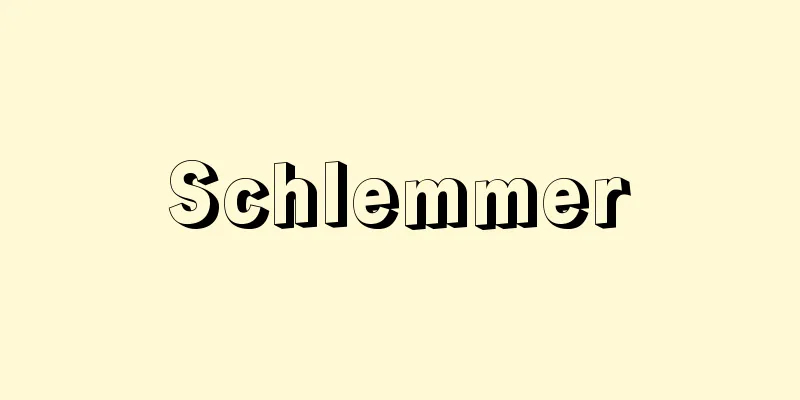Genes

|
A structural unit within a cell that determines hereditary traits. A gene is a part of a nucleic acid molecule that is passed on to offspring through self-replication and determines the structure of a protein through transcription and translation, thereby expressing hereditary traits. [Tatsuo Ishikawa] Development of the concept of genesMendel, who was a priest at a monastery in the town of Brno in the Czech Republic, published a paper titled "Experiments on Plant Hybrids" in 1865, summarizing the results of his experiments on crossbreeding pea plants. This paper presented the principles of heredity that would later come to be known as "Mendel's Law." In it, Mendel hypothesized the existence of elements that are transmitted from parents to offspring through reproductive cells and determine hereditary traits, which he called "elements." The elements of heredity that Mendel first identified were given the German name "Gen" by the Danish geneticist Johansen in 1909, and came to be called "genes" in Japanese. Later, the relationship between genes and chromosomes was elucidated mainly through research using fruit flies, and genes came to be considered to be particles that are linearly arranged on chromosomes, as the American geneticist T. H. Morgan claimed in his book "The Gene Theory" in 1926. In the 1940s, with the development of genetic biochemistry and molecular genetics research, it was revealed that genes are a type of nucleic acid that makes up chromosomes and that they control the action of enzyme molecules to determine hereditary traits. In the 1960s, the genetic code of genes was completely deciphered, and the mechanism of expression of genetic information was elucidated. In the 1970s, artificial synthesis of genes became possible, and genetic engineering technology was developed to introduce genes extracted from cells into cells of a different species for proliferation and use. [Tatsuo Ishikawa] The body of the geneThe main body of genes is deoxyribonucleic acid (DNA), a type of nucleic acid. Exceptionally, in some viruses, ribonucleic acid (RNA) functions as genes. The fact that genes are DNA was first proven in 1944 by three Americans, Avery, CM MacLeod, and M. McCarty, in a transformation experiment using pneumonia bacteria. They found that when DNA was extracted from wild-type pneumonia bacteria cells that had a polysaccharide membrane and were pathogenic, and added it to mutant cells that did not have a polysaccharide membrane and were non-pathogenic, the mutant cells changed to the wild type, and concluded that the genes that determine the membrane structure and pathogenicity of the wild type or mutant type are DNA. Later, in 1952, American researchers Hershey and Chase proved that it was DNA that carried the genetic information necessary for the proliferation of bacteriophage T2 based on their research into the life cycle of T2, confirming that genes are DNA. [Tatsuo Ishikawa] Structure and replication of genetic DNADNA is a polymeric substance formed by the binding of many deoxyribonucleotides. Deoxyribonucleotides are composed of phosphate, deoxyribose (a type of sugar), and purine or pyrimidine bases. The bases that make up DNA are adenine (A), guanine (G), cytosine (C), and thymine (T). In 1953, American biologist Watson and British physicist Crick worked together to propose the "double-stranded model of DNA," which shows the molecular structure of genetic DNA. This model states that a DNA molecule consists of two long chains formed by the binding of deoxyribonucleotides, wound in a helix ( ). The two chains are linked to form base pairs between A and T, and G and C, forming a double helix structure. The diameter of the double helix is 2.0 nanometers, the distance of one turn of the helix is 3.4 nanometers, and 10 base pairs are lined up in between. The order of the bases that make up such a DNA chain acts as a genetic code and determines genetic information. The length of the double strand of DNA molecules varies depending on the species, but the DNA molecule of Escherichia coli, which is often used in genetic research, is about 1.1 mm long, consists of millions of base pairs, and has a molecular weight of about 2.5 billion. E. coli is thought to have about 3,000 genes, each of which consists of more than 1,000 base pairs, and the average molecular weight is estimated to be several million. When cells divide, genes are duplicated and passed on to descendent cells. When a DNA molecule replicates, the double helix is partially unwound to form a single strand, and each strand is used as a template to synthesize a new pair of strands by the action of DNA polymerase. In this way, DNA molecule replication is self-replication, and because a new molecule is created from one of the double strands, it is called semi-conservative replication. [Tatsuo Ishikawa] Genes and ChromosomesIn the cells of eukaryotes, such as higher animals and plants, DNA is contained in the nucleus, and during cell division it becomes chromosomes, which are distributed to descendent cells. The substance that makes up the nucleus and chromosomes is called chromatin. Chromatin contains DNA, proteins, mainly histones, and small amounts of RNA. DNA molecules bind to histone particles to form unit structures called nucleosomes, which are folded to form the nucleus and chromosomes. In the cells of prokaryotes, such as bacteria, nuclei and chromosomes seen in eukaryotic cells are not formed during cell division, and DNA molecules are distributed naked in the cytoplasm without forming a chromatin structure. Genes are arranged linearly in a certain order on chromosomes. When two genes are on different chromosomes, they will separate according to Mendel's law of independent assortment as a result of hybridization, but when they are on the same chromosome, they will not follow this law and will act together, showing the phenomenon of linkage. Genes on one chromosome form a linkage group. As a result of hybridization, the combination of linked genes may change to a different combination from that of the parents, a phenomenon called genetic recombination. Recombination occurs when crossing over and recombination occurs between homologous chromosomes that have paired during meiosis I, resulting in a new genetic combination, or recombinant type. The frequency of occurrence of recombinant types, expressed as a percentage, is called the recombination value. If the recombination value is taken as the distance between genes and scaled on a line, a diagram showing how the genes are arranged on the chromosomes can be drawn. This diagram is called a chromosome map, genetic map, or linkage map. Recombination is thought to occur through cross-cleavage between DNA molecules and recombination with homologous partner molecules. During the recombination process, enzymes that cut DNA strands, repair enzymes, and ligases work. Enzymes that cut specific base sequence sites in DNA strands are called restriction enzymes. Two types of DNA strands cut with the same restriction enzyme have complementary structures at the cut ends, and the molecule created by combining them is called recombinant DNA. Recombinant DNA can be created between gene DNA and the DNA of a plasmid that replicates itself in the cytoplasm, increasing the number of copies of a gene. This phenomenon is called gene cloning, and is the main method of genetic engineering. [Tatsuo Ishikawa] Function of genesGenes determine hereditary traits. In 1941, American geneticists Beadle and Tatum studied biochemical mutants involved in vitamin synthesis in Neurospora crassa and proposed the "one gene, one enzyme" hypothesis. This hypothesis states that a gene controls the structure and function of an enzyme, which then results in the expression of hereditary traits. Later, as Crick asserted in 1958 as the central dogma, the genetic information in DNA is first transcribed into messenger RNA, which then moves to the cytoplasm ( ). In the cytoplasm, the messenger RNA attaches to small particles called ribosomes, where it is translated by the action of transfer RNA and other molecules, and amino acids are linked according to the genetic code to synthesize polypeptide chains of proteins ( ). Proteins act as enzymes to catalyze metabolic reactions within cells, and also form cellular structures and contribute to the expression of hereditary traits. The genetic code of genes was deciphered over a period of about five years, beginning in 1961. The genetic code that was deciphered is one in which three nucleotides in genetic DNA become a code unit called a codon, which specifies one amino acid ( ), and is also known as a triplet code. There are 64 types of codons, 61 of which specify one of the 20 amino acids that make up proteins. Three codons do not specify any amino acid, and act as the end code for reading the genetic code. The code for methionine (AUG) is the start code for reading the genetic code. All living organisms, from viruses to humans, use the same genetic code. Whether a gene is active or inactive is controlled by regulatory genes and environmental conditions. In 1961, F. Jacob and J. L. Monod of France proposed the "operon theory" based on their research into the regulatory mechanism of lactose metabolism in Escherichia coli, which states that enzyme synthesis is regulated by regulatory genes in groups of genes called operons. According to the operon theory, when there is no lactose during culture of Escherichia coli, a regulatory substance (a protein called an inhibitor) produced by a regulatory gene binds to one end of the operon (called the operator) and stops enzyme synthesis, but when lactose is added, the inhibitor is inactivated and enzymes are synthesized from the operon. Eukaryotic cells have many genes, but only genes specific to the tissue are active, and the rest are inactive. This mechanism of gene action regulation in eukaryotic cells is thought to be closely related to chromosome structure. [Tatsuo Ishikawa] mutationGenes are usually maintained in a very stable state, but occasionally they can change. The phenomenon in which the structure of a gene changes and the genetic information changes is called a mutation. Spontaneous mutations occur naturally without any special treatment. The frequency of mutations occurring within a certain period of time is indicated by the mutation rate. The spontaneous mutation rate differs depending on the species of organism and the gene, but in microorganisms the mutation rate is generally low, about 1 in 100 million, while in higher animals and plants it is often 1 in 100,000 or even higher. The mutation rate increases when cells are exposed to X-rays or treated with chemicals that act on DNA, such as alkylating agents. Mutations are induced when the genetic code is changed by DNA base pair substitutions, deletions, translocations, inversions, insertions, etc., changing the amino acid that is specified. [Tatsuo Ishikawa] Microstructural units of genesWhen many mutants of the same gene are isolated and crossed with each other, recombinant forms are obtained at low frequency. If the recombination values between each mutant are plotted on a line, a fine structure map of the gene is obtained. All the changes at different positions of the gene are called alleles. Each point on the fine structure map corresponds to a single base pair in a DNA molecule. The smallest unit of mutation that occurs within a gene is called a muton, and the smallest unit of recombination is called a recon. These units correspond to a single base pair, and a gene can be said to be made up of many such units. When three bases are assembled, they become a codon of the genetic code. A gene is a combination of codons, and the genetic code determines the amino acid sequence of a polypeptide chain. When two mutants of the same gene are located on different chromosomes in the same cell, they usually show a mutant trait, but sometimes they cooperate to show the wild-type trait. Such mutations are said to belong to different functional units within a gene called cistrons. A cistron is a genetic unit that corresponds to a continuous polypeptide chain that makes a protein. Usually, a gene consists of one cistron and carries the genetic information for one type of polypeptide chain, but occasionally a gene consists of two cistrons and carries the genetic information for two types of polypeptide chains. [Tatsuo Ishikawa] Gene symbols and typesThe name of a gene is represented by a gene symbol. A gene symbol is made up of an English or Latin abbreviation that indicates the characteristic trait that the gene determines, plus a number or symbol. For example, the symbol for the gene that indicates the requirement of tryptophan, a type of amino acid, in a microorganism is trp. There are several enzyme reactions in the tryptophan synthesis system, and the genes that control each reaction are given numbers or letters and called trp1, trp2 or trpA, trpB, etc. In fruit flies, the gene for the whites of the eyes is W, and the gene for curved wings is Cy. Lowercase letters indicate recessive genes, and uppercase letters indicate dominant genes. Apart from the proper name of genes, they are classified according to the part of the cell in which they are located, the traits they control, and the function they perform. Genes in the nucleus are called nuclear genes or chromosomal genes, while genes in the cytoplasm that cause cytoplasmic inheritance are called cytoplasmic genes. Genes in the mitochondria of the cytoplasm are called mitochondrial genes or chondriomes, and genes in the plastids are called plastomes. According to the one gene, one enzyme theory, structural genes determine the structure of proteins, and regulatory genes induce or suppress the function of structural genes. Genes that have a lethal effect during the development of an individual organism are called lethal genes. Normal genes commonly found in nature are wild-type genes, and when they change, they become mutant genes. Major genes control one trait and segregate according to Mendel's law, while minor genes control quantitative traits and do not segregate according to Mendel's law. Multiple genes may be active in expressing one trait, and are called duplicate genes or synonymous genes, respectively. In addition to these, numerous gene names have been described to represent various genetic phenomena. [Tatsuo Ishikawa] "Molecular Biology of Genes, Volumes 1 and 2, by Watson, translated by Kinichiro Miura et al. (3rd edition, 1976, Kagaku Dojin) " "The Story of Genes, by Hoagland, translated by Yasuo Ichiba (1981, Shakai Shisosha)" "Introduction to Molecular Genetics, by Tatsuo Ishikawa (Iwanami Shinsho)" [References] | | LawsAs shown in Figure A, a DNA molecule is thought to be composed of two long chains wound in a spiral shape, each of which is made up of bases (A, G, C, T) bound to deoxyribose (S) and phosphate (P). In Figure B, the transmission of genetic information from DNA in the nucleus begins with a part of this spiral being unwound, and one of the strands is used as a template to be transcribed into messenger RNA (U, C, G, A are molded into the messenger RNA for the DNA bases A, G, C, T, respectively). The messenger RNA leaves the nucleus and travels to the cytoplasm, where it attaches to a ribosome. Here, it is translated by transfer RNAs that carry amino acids, and amino acids are successively bound according to the genetic code to form a peptide chain (protein molecule). ©Shogakukan "> Double-stranded DNA model (Figure A) and the structure of genes... Source: Shogakukan Encyclopedia Nipponica About Encyclopedia Nipponica Information | Legend |
|
遺伝形質の決定に働く細胞内の構造単位。遺伝子は核酸分子の一部であり、自己複製により子孫に伝えられ、また転写と翻訳によりタンパク質の構造を決定し、その働きにより遺伝形質を発現する。 [石川辰夫] 遺伝子概念の発展チェコのブルノの町で修道院の司祭をしていたメンデルは1865年にエンドウの交雑実験の結果をまとめて『植物雑種の研究』という論文を発表した。この論文はのちに「メンデルの法則」とよばれるようになった遺伝の原理を示したものであるが、このなかでメンデルは、親から子孫に生殖細胞を通して伝えられ、遺伝形質を決定するものの存在を推定し、これを「要素」とよんだ。メンデルが初めて明らかにした遺伝の要素は、1909年にデンマークの遺伝学者のヨハンセンによってドイツ語でゲンGenと名づけられ、日本語では「遺伝子」とよばれるようになった。その後、主としてショウジョウバエを用いた研究から遺伝子と染色体の関係が明らかにされ、アメリカの遺伝学者T・H・モーガンが1926年にその著書『遺伝子説』で主張したように、遺伝子は染色体上に線状に配列する粒子であると考えられるようになった。1940年代には、遺伝生化学や分子遺伝学研究が発展し、遺伝子は染色体をつくる核酸の一種であり、酵素分子の働きを支配して遺伝形質を決定することが明らかにされた。1960年代には、遺伝子のもつ遺伝暗号がすべて解読され、遺伝情報の発現機構が解明された。さらに1970年代には、遺伝子の人工合成が可能になり、また細胞から取り出した遺伝子を異種の細胞に入れて増殖させ利用する遺伝子工学技術が発展してきた。 [石川辰夫] 遺伝子の本体遺伝子の本体は核酸の一種デオキシリボ核酸(DNA)である。例外的にある種のウイルスではリボ核酸(RNA)が遺伝子として働く。遺伝子がDNAであることは1944年アメリカのエーブリー、マクレオドC. M. MacLeod、マッカーティーM. McCartyの3人により、肺炎菌を用いた形質転換実験により初めて証明された。彼らは肺炎菌で多糖類の膜をもち、病原性のある野生型細胞からDNAを抽出し、多糖類の膜をもたず、病原性のない突然変異型細胞に加えると、突然変異型が野生型に変化することをみいだし、膜構造と病原性が野生型か突然変異型かを決定している遺伝子はDNAであると結論した。その後、1952年にはアメリカのハーシェイとチェイスがバクテリオファージT2の生活史の研究から、T2の増殖に必要な遺伝情報をもつのはDNAであることを証明し、遺伝子がDNAであることが確認された。 [石川辰夫] 遺伝子DNAの構造と複製DNAは多数のデオキシリボヌクレオチドが結合してできた高分子物質である。デオキシリボヌクレオチドはリン酸、デオキシリボース(糖の一種)、プリンまたはピリミジン塩基が結合したものである。DNAをつくる塩基は、アデニン(A)、グアニン(G)、シトシン(C)、チミン(T)の4種である。1953年にアメリカの生物学者ワトソンとイギリスの物理学者クリックは協力して遺伝子DNAの分子構造を示す「DNAの二重鎖モデル」を提出した。このモデルは、DNA分子はデオキシリボヌクレオチドが結合してできた2本の長い鎖が螺旋(らせん)状に巻いた構造からなるというものである()。2本の鎖はAとT、GとCが塩基対をつくるように結び付き、二重螺旋構造をとっている。二重螺旋の直径は2.0ナノメートル、螺旋の1回転の距離は3.4ナノメートルで、その間に塩基対が10個並んでいる。このようなDNA鎖をつくる塩基の配列順序は遺伝暗号として働き、遺伝情報を決定するものである。DNA分子の二重鎖の長さは種によって異なるが、遺伝学研究によく用いられる大腸菌のDNA分子の長さは約1.1ミリメートルで、数百万の塩基対からなり、その分子量は約25億である。大腸菌は約3000の遺伝子をもつと考えられ、一つの遺伝子は1000余りの塩基対からなり、平均して分子量が数百万と推定される。 遺伝子は細胞分裂のとき正しく同じものに複製され、子孫細胞に伝えられる。DNA分子の複製のときには、二重螺旋構造は部分的に巻き戻されて1本鎖となり、それぞれの鎖を鋳型として、DNA合成酵素の働きにより対になる新しい鎖が合成される。このようにDNA分子の複製は自己複製であり、また二重鎖の1本から新しい分子がつくられるので半保存的複製とよばれる。 [石川辰夫] 遺伝子と染色体高等動植物など真核生物の細胞では、DNAは核に含まれ、細胞分裂のときには染色体となり、子孫細胞に分配される。核や染色体をつくっている物質はクロマチンとよばれる。クロマチンはDNA、ヒストンを主とするタンパク質、少量のRNAを含む。DNA分子はヒストン粒と結合し、ヌクレオソームnucleosomeとよばれる単位構造をつくり、折り畳まれて、核や染色体を構成する。細菌類など原核生物の細胞では、細胞分裂のとき真核細胞でみられるような核や染色体をつくらず、DNA分子はクロマチン構造をとることなく、裸の状態で細胞質中に分布している。 遺伝子は染色体上に一定の順序で線状に配列している。二つの遺伝子が異なる染色体上にあるときには、交雑の結果メンデルの独立の法則に従って分離するが、同じ染色体上にあるときにはこの法則に従わず、行動をともにし、連鎖の現象を示す。1本の染色体上の遺伝子は一つの連鎖群を形成する。交雑の結果、連鎖している遺伝子の組合せが親と異なる組合せに変わることがあり、この現象は遺伝的組換えとよばれる。組換えは減数第1分裂の過程で対合した相同染色体の間で交叉(こうさ)とつなぎ換えがおこり、新しい遺伝子組合せ、すなわち組換え型が生ずる現象である。組換え型の出現頻度をパーセント(%)で示した値を組換え価とよぶ。組換え価を遺伝子間の距離とし、これを線上に目盛ると、遺伝子が染色体上にどのように並んでいるかを示す図ができる。この図は染色体地図、遺伝地図、あるいは連鎖地図とよばれる。 組換えはDNA分子間の交叉切断と、相同な相手分子へのつなぎ換えによっておこると考えられている。組換え過程では、DNA鎖の切断酵素、修復酵素、連結酵素などが働いている。DNA鎖の特定塩基配列部位を切る酵素は制限酵素とよばれる。同じ制限酵素で切った2種のDNA鎖は切り口の構造が相補的であり、それらを結合してできた分子は組換えDNAとよばれる。遺伝子DNAと細胞質で自己増殖するプラスミドのDNAの間で組換えDNAをつくり、遺伝子のコピーを増やすことができる。これは遺伝子のクローン化とよばれる現象で、遺伝子工学の主要な手段となっている。 [石川辰夫] 遺伝子の働き遺伝子は遺伝形質を決定する。アメリカの遺伝学者のビードルとテータムは1941年にアカパンカビのビタミン合成に関する生化学的突然変異体の研究を行い、「一遺伝子一酵素説」を提唱した。この仮説は、遺伝子は一つの酵素の構造や働きを支配し、遺伝形質を発現するとするものである。その後、1958年にクリックがセントラルドグマとして主張しているように、遺伝子DNAの遺伝情報はまず伝令RNAに転写されて、細胞質に移動する()。細胞質では伝令RNAはリボゾームとよばれる小粒に付着し、運搬RNAなどの働きで翻訳され、遺伝暗号に従ってアミノ酸が結合され、タンパク質のポリペプチド鎖が合成される()。タンパク質は酵素として細胞内の代謝反応を触媒し、また細胞構造をつくり遺伝形質の発現に働く。 遺伝子のもつ遺伝暗号は、1961年から約5年間に解読された。解読された遺伝暗号は、遺伝子DNAの三つのヌクレオチドがコドンcodonとよばれる暗号の単位となって一つのアミノ酸を指定するというもので()、トリプレット暗号ともいわれる。コドンは64種あり、そのうち61種はタンパク質をつくる20種のアミノ酸のどれかを指定する。3種のコドンはどのアミノ酸も指定せず、遺伝暗号の読みの終了暗号として働く。また、メチオニンの暗号(AUG)は遺伝暗号の読みの開始暗号となる。ウイルスからヒトに至るまで、どの生物も同じ遺伝暗号を用いている。 遺伝子が働くか働かないかは、調節作用をもつ遺伝子や環境条件などにより調節されている。フランスのF・ジャコブとJ・L・モノーは1961年に大腸菌の乳糖代謝の調節機構の研究から、酵素合成が調節遺伝子によりオペロンとよばれる遺伝子群を単位として調節されるという「オペロン説」を提出した。オペロン説によると、大腸菌の培養中に乳糖がないときには、調節遺伝子からつくられる調節物質(抑制体とよばれるタンパク質)がオペロンの一端(オペレーターとよばれる)に結合し酵素合成を止めているが、乳糖が加えられると抑制体は不活性化され、オペロンから酵素が合成される。真核細胞は多数の遺伝子をもつが、組織に特有の遺伝子のみが働き、ほかは働きを停止している。このような真核細胞における遺伝子作用調節機構は、染色体構造と密接な関係をもつものと考えられている。 [石川辰夫] 突然変異遺伝子は普通、非常に安定した状態で保たれているが、まれに変化することがある。遺伝子の構造が変化し、遺伝情報が変わる現象は突然変異とよばれる。特別な処理をしないで自然の状態でおこるのは自然突然変異である。突然変異が一定時間内にどのくらいの頻度でおこっているかは突然変異率で示される。自然突然変異率は生物種により、また遺伝子ごとに異なるが、微生物では一般に突然変異率が低く、1億分の1くらいであり、高等動植物では10万分の1、あるいはそれ以上の場合が多い。細胞をX線照射したり、アルキル化剤のようなDNAに作用する化学物質で処理すると、突然変異率が上昇する。突然変異はDNA塩基対の置換、欠失、転座、逆位、挿入などにより、遺伝暗号が変化し、指定するアミノ酸が変わることにより、誘発される。 [石川辰夫] 遺伝子の微細構造単位同じ遺伝子の突然変異体を多数分離して相互に交雑すると、低頻度ではあるが組換え型が得られる。各突然変異体の間の組換え価を直線上に目盛ると、遺伝子の微細構造地図が得られる。遺伝子の異なる位置の変化したものはすべて対立遺伝子とよばれる。微細構造地図上の点はDNA分子の1塩基対に対応する。遺伝子内でおこる突然変異の最小単位はミュトンmuton、組換えの最小単位はリコンreconとよばれるが、これらの単位は一つの塩基対に対応するもので、遺伝子はこのような単位が多数集まってできているといえる。三つの塩基が集合すると、遺伝暗号のコドンとなる。遺伝子はコドンの連結したもので、その遺伝暗号によりポリペプチド鎖のアミノ酸配列が決定される。同じ遺伝子の二つの突然変異が、同じ細胞内の異なる染色体上にあるときには、普通は突然変異形質を示すが、ときには助けあって野生型形質を表すことがある。このような突然変異は、シストロンcistronとよばれる遺伝子内の異なる働きの単位に属すとされる。シストロンはタンパク質をつくる一続きのポリペプチド鎖に対応する遺伝単位である。普通、遺伝子は一つのシストロンからなり、1種のポリペプチド鎖の遺伝情報をもつが、まれに二つのシストロンからなり、2種のポリペプチド鎖の遺伝情報をもつものがある。 [石川辰夫] 遺伝子記号と種類遺伝子の名称は遺伝子記号で表される。遺伝子記号は、その遺伝子の決定する形質の特徴を示す英語やラテン語などの省略形と番号や記号からつくられる。たとえば、微生物でアミノ酸の一種であるトリプトファンの要求性を示す遺伝子の記号はtrpである。トリプトファン合成系にはいくつもの酵素反応があり、それぞれの反応を支配する遺伝子には番号やアルファベットをつけtrp1、trp2あるいはtrpA、trpBのようによぶ。ショウジョウバエの白眼の遺伝子はWで、はねの曲がったものはCyである。小文字は劣性、大文字は優性遺伝子である。 遺伝子の固有名とは別に、遺伝子が細胞のどの部分にあるか、どんな形質を支配するか、どんな働きをするかなどにより、種類分けがなされている。核にある遺伝子は核遺伝子、または染色体遺伝子であり、細胞質にあって細胞質遺伝の原因となるのは細胞質遺伝子である。細胞質のミトコンドリアにあればミトコンドリア遺伝子、あるいはコンドリオーム、色素体にあれば色素体遺伝子、あるいはプラストムとよばれる。一遺伝子一酵素説に従いタンパク質の構造を決定しているのは構造遺伝子であり、構造遺伝子の働きを誘導したり抑制したりしているのが調節遺伝子である。また、生物個体の発生過程で致死作用を示す遺伝子は致死遺伝子といわれる。自然界に普通にみられる正常な遺伝子は野生型遺伝子で、変化すると突然変異型遺伝子になる。一つの形質を支配し、メンデルの法則に従った分離をするのが主働遺伝子であり、量的形質を支配し、メンデル式分離をしないのが微働遺伝子である。また、一つの形質を発現するのに複数の遺伝子が働いていることがあり、それぞれ重複遺伝子、あるいは同義遺伝子とよばれる。これらのほかにも、各種の遺伝現象を表すため多数の遺伝子名が記載されている。 [石川辰夫] 『ワトソン著、三浦謹一郎他訳『遺伝子の分子生物学』上下(第3版・1976・化学同人)』▽『ホーグランド著、市場泰男訳『遺伝子のはなし』(1981・社会思想社)』▽『石川辰夫著『分子遺伝学入門』(岩波新書)』 [参照項目] | |図AのようにDNA分子は塩基(A、G、C、T)にデオキシリボース(S)とリン酸(P)が結合したものが連続してできた2本の長い鎖が螺旋状に巻いた構造からなると考えられている。図Bにおける核中のDNAの遺伝情報伝達は、まず、この螺旋の一部が巻き戻され、片方の鎖が鋳型となって伝令RNAに転写される(DNAの塩基のA、G、C、Tに対し、それぞれU、C、G、Aが伝令RNAに鋳込まれる)。伝令RNAは核を出て細胞質へ移動し、リボソームに付着する。ここで、アミノ酸を運ぶ運搬RNAなどの働きで翻訳され、遺伝暗号に従ってアミノ酸が次々に結合され、ぺプチド鎖(タンパク質分子)が形成される©Shogakukan"> DNAの二重鎖モデル〔図A〕と遺伝子の… 出典 小学館 日本大百科全書(ニッポニカ)日本大百科全書(ニッポニカ)について 情報 | 凡例 |
Recommend
Inui Tomiko
Children's literature author. Her real name w...
MHD power generation
This is a method of generating electricity using ...
Morazán, Francisco
Born: October 16, 1799 in Tegucigalpa [Died] Septe...
Jhansi
A city in the southwest of Uttar Pradesh, northern...
Municipal Police - Jichitaikeisatsu
In a broad sense, it means a police organization ...
Mintaka Pass (English spelling)
A pass near the border crossing of Pakistan, Afgha...
Quail
…Today, quails are efficiently raised for egg pro...
Inugusu - Inugusu
→ Machilus Source : Heibonsha Encyclopedia About M...
Katsuragawa Hosan
Year of death: Bunka 7.12.4 (1810.12.29) Year of b...
Women's Roof - Onna no Yane
...In Aichi and Gifu, there is a custom in which ...
Kashmiri (English spelling)
...There is a considerable movement of population...
Aenictus
…General term for ants belonging to the family Fo...
Volcanology
A branch of earth science that aims to elucidate ...
Homage to the Square
…He then entered the Bauhaus in 1920 and became a...
jhapeti (English spelling)
… [Uchibori Motomitsu] [Cremation in Japan] In Bu...
![Sanriku [town] - Sanriku](/upload/images/67cbb7969e84e.webp)








